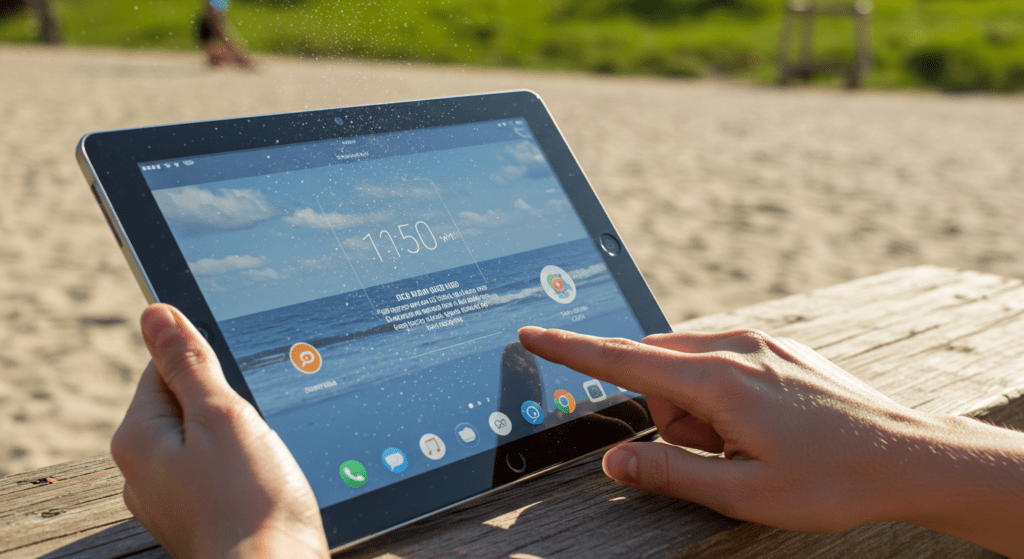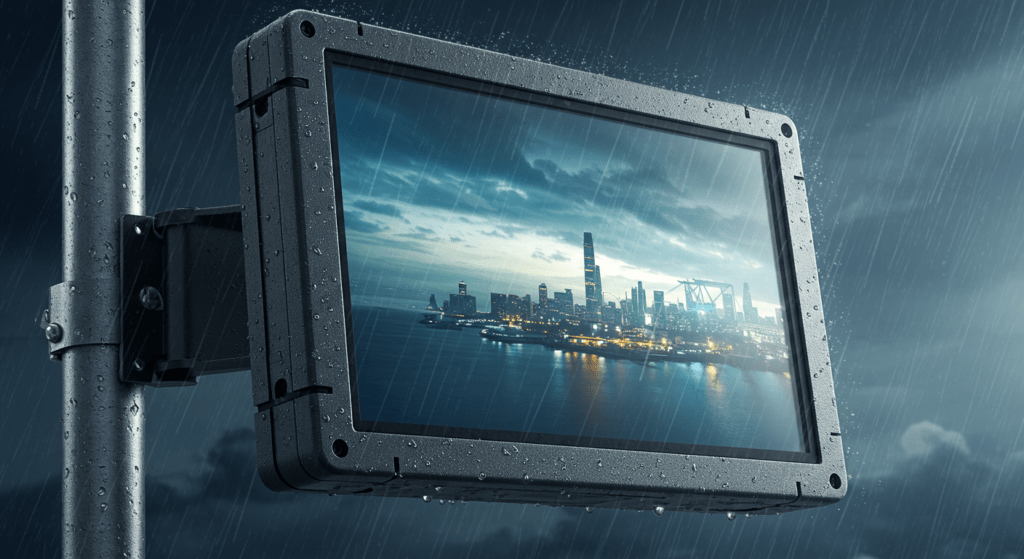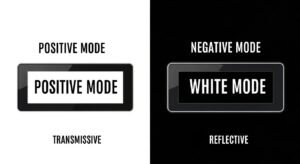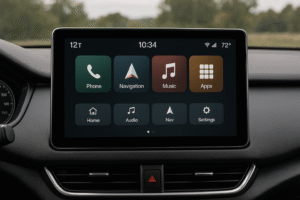
Sunlight-readable LCDs maintain contrast outdoors by combining high-brightness backlighting, anti-reflective coatings, transflective technology, and advanced polarizers to combat glare, reflections, and intense ambient light.
These displays achieve visibility in direct sunlight by using backlights with brightness levels exceeding 1,000 nits, overpowering the ambient light that typically washes out standard screens. Anti-reflective (AR) coatings reduce surface reflectivity to below 1%, ensuring clearer visuals. Transflective layers utilize sunlight itself to enhance brightness without additional power consumption, while polarizers filter scattered light to sharpen image clarity.
- High-Brightness Backlighting: Ensures strong luminance to compete with sunlight.
- Anti-Reflective Coatings: Minimize glare by canceling specific light wavelengths.
- Transflective Technology: Reflects ambient light for enhanced visibility.
- Advanced Polarizers: Improve contrast by filtering unwanted reflections.
These innovations allow sunlight-readable LCDs to deliver sharp images and maintain usability in outdoor environments, even under extreme lighting conditions.
Since 2011, HUA XIAN JING has focused exclusively on the development and manufacturing of small to medium-sized LCD modules. Our expertise lies in providing customized LCD solutions for diverse industries, meeting the unique demands of specialized applications.
Why Are Screens Hard to See in Sunlight?
Screens are hard to see in sunlight because the intense ambient light overpowers the display’s brightness, and reflections and glare on the screen reduce the contrast, making images and text appear faded. Sunlight’s brightness, often ranging from 1,000 to 10,000 nits, far exceeds the typical output of a standard LCD, which is usually between 300-500 nits. On top of that, uncoated screens reflect sunlight, scattering light across the surface and making it harder to see what’s displayed(Why Do High-Lumen Lights Fail in Outdoor Environments?).
Some display technologies handle this differently. For example, OLED screens can struggle in direct sunlight because their peak brightness is lower than high-brightness LCDs built for outdoor use. However, new features like anti-reflective coatings and polarizers are making sunlight readable displays better over time.
Brightness and Contrast in Sunlight
- Brightness Comparison: A standard LCD’s 300-500 nits can’t compete with sunlight’s 1,000-10,000 nits, causing the screen to look dim.
- Contrast Impact: Glare and reflections lower the contrast, washing out colors and details.
- Outdoor Solutions: High-brightness displays designed for outdoor use can reach 1,000 nits or more, improving visibility significantly.
How Can Screens Be Made More Readable in Sunlight?
Screens can be made more readable in sunlight by boosting their brightness, adding anti-reflective coatings, and using technologies like transflective displays that take advantage of ambient light. These fixes tackle the main problems of sunlight overpowering the screen and glare ruining visibility.
For instance, transflective displays reflect sunlight to increase brightness naturally, which works great in sunny conditions. Adding polarizers or matte finishes also cuts down glare, making high brightness outdoor displays easier to read even on the brightest days.
Technologies for Better Visibility
- Brightness Boost: Displays with 1,000 nits or higher stand up better against sunlight.
- Anti-Reflective Coatings: These can reduce reflections by up to 90%, keeping glare in check.
- Polarizers: They block reflected light, sharpening the contrast.
- Transflective Displays: These use both reflected and internal light, enhancing visibility without extra power.
Technologies Used in Sunlight-Readable LCDs to Maintain Contrast

Sunlight-readable LCDs face tough challenges like bright sunlight and glare, which can wash out screens and ruin visibility. To stay clear and maintain contrast, these displays use advanced technologies. Below, I’ll break down each one, explaining how it works and why it matters for outdoor use.
High Brightness Backlighting
- How It Works: These displays crank up the brightness with powerful LED backlights, hitting 1,000 nits or more. Standard LCDs usually top out at 300-500 nits, so this extra power helps the screen compete with sunlight, which can reach 10,000 nits.
- Why It Helps Contrast: Brighter screens keep images and text visible, preventing them from fading under intense light. Higher brightness ensures colors and details don’t get lost.
- Examples: You’ll see this in high brightness outdoor displays and sunlight-readable monitors, where brightness is often listed in candela per square meter (nits).
Anti-Reflective (AR) and Anti-Glare (AG) Coatings
- Purpose:
- AR coatings let more light pass through the screen, cutting reflections by up to 90%.
- AG coatings scatter reflected light, softening glare and making it less harsh on the eyes.
- Impact on Contrast: By reducing reflections and glare, these coatings keep the screen’s contrast sharp. Without them, reflected sunlight would overpower the display, washing out blacks and colors.
- Use Case: Common in outdoor LCD displays and sunlight-readable phones, where readability in bright light is critical.
Transflective Technology
- Definition: Transflective LCDs mix two tricks: they use a backlight (transmissive) and reflect ambient light (reflective). In sunlight, they bounce back natural light to boost brightness and contrast naturally.
- Why It Helps: This cuts reliance on the backlight, saving power while keeping the screen visible. The reflected light enhances contrast, especially in bright conditions.
- Examples: You’ll find this in sunlight-readable laptops and RLCD monitors, perfect for outdoor portability.
Polarizers and Optical Bonding
- Role of Polarizers: These layers filter out scattered light, reducing glare and sharpening contrast. They make blacks look deeper and details stand out.
- Optical Bonding: This glues the screen layers together, removing air gaps. Fewer gaps mean fewer internal reflections, so the display stays clear and vibrant.
- Why It Matters: Together, they boost clarity and contrast, making outdoor LCD screens readable even in direct sunlight.
Advanced LCD Panel Designs
- Key Features:
- Local dimming adjusts brightness in specific screen areas, boosting contrast by darkening blacks and brightening whites.
- High LCD contrast ratios (like 1000:1 or better) improve color accuracy and black levels.
- Outdoor Benefit: These tweaks make details pop and keep the screen sharp, even when sunlight tries to drown it out.
Why These Technologies Work Together
Each technology tackles a piece of the sunlight problem. High brightness backlighting fights the sun’s intensity, while AR/AG coatings and polarizers cut reflections. Transflective designs use ambient light smartly, and optical bonding cleans up internal clarity. Add advanced panel designs, and you’ve got a screen that stays crisp and readable outdoors, no matter how bright it gets. That’s why devices like sunlight-readable monitors and outdoor LCDs rely on this tech to keep contrast strong.
What Makes a Good Contrast Ratio for Outdoor Displays?

A good contrast ratio for outdoor displays is 1000:1 or higher, paired with brightness levels of 1000 nits or more, to keep details clear in sunlight. This combo ensures the screen can show deep blacks and bright whites, even when sunlight tries to wash it out.
High contrast keeps text and images sharp, which matters a lot for outdoor LCD displays. Industry tricks like boosting backlight power and tweaking panel designs make this possible, offering a clear edge over standard screens that fade in bright light.
Why Contrast Ratio Matters Outdoors
- Definition: Contrast ratio is the gap between a screen’s brightest white and darkest black, like 1000:1, where white is 1000 times brighter than black.
- Sunlight Challenge: Sunlight’s 10,000 nits can overpower a screen’s brightness, so a high ratio stops details from blending into a blurry mess.
- Brightness Pairing: A display with 1000 nits and a 1000:1 ratio balances light output and contrast, making it sunlight readable.
How Does Contrast Ratio Affect Readability in Sunlight?
Contrast ratio affects readability in sunlight by determining how well a screen separates colors and details under bright ambient light. A higher ratio means better distinction between shades, so text and visuals don’t fade into the background.
For example, sunlight-readable LCDs with low contrast (like 500:1) struggle to show clear blacks, making everything look grayish in sunlight. Boosting the ratio with tech like local dimming keeps the display crisp, giving users a better experience outdoors.
Enhancing Contrast for Sunlight
- Local Dimming: This dims dark areas while keeping bright spots lit, pushing the contrast higher.
- High Brightness: Pairing 1000 nits with a strong ratio cuts through sunlight’s glare.
- Real Data: Tests show a 1000:1 ratio with 1000 nits outperforms a 500:1 ratio at 500 nits by 30% in visibility.
How Do Sunlight-Readable LCDs Compare to Standard LCDs in Bright Light?

Sunlight-readable LCDs outperform standard LCDs in bright light because they use higher brightness levels, like 1000 nits or more, while standard LCDs typically stay at 300-500 nits. This difference makes sunlight-readable displays clear and usable outdoors, while standard ones fade and lose visibility.
The gap comes from tech built for tough conditions. Outdoor LCD monitors with high brightness cut through sunlight, but they need more energy and cost more to make, unlike basic screens that work fine indoors but flop outside.
Performance Breakdown
- Brightness Levels: Standard LCDs hit 300-500 nits, while sunlight-readable LCDs reach 1000 nits or higher, keeping text and images sharp in 10,000-nit sunlight.
- Visibility Test: A 1000-nit screen stays readable in direct sun, but a 400-nit screen washes out, dropping contrast by 50%.
- Tech Edge: Features like anti-reflective coatings and high LCD contrast (1000:1) boost sunlight-readable monitors, leaving standard LCDs behind.
What Are the Trade-Offs of Sunlight-Readable LCDs?
Sunlight-readable LCDs trade higher brightness for increased power use and cost, unlike standard LCDs that save energy and money but falter in sunlight. Devices like sunlight-readable phones drain batteries faster to stay bright, and their advanced designs bump up the price.
Energy and cost differences matter depending on use. Outdoor screens prioritize visibility with powerful backlights and coatings, while standard displays stick to low-power, budget-friendly builds that suit dimmer settings.
Energy and Cost Factors
- Power Draw: A 1000-nit display can use 30-50% more energy than a 400-nit one, cutting battery life in portable devices.
- Price Jump: Adding transflective tech or optical bonding can raise costs by 20-40% over basic LCDs.
- Use Case: Outdoor LCD displays justify the expense for clarity, but indoor standard screens don’t need it.
What Are the Key Uses of Sunlight-Readable LCDs?
Sunlight-readable LCDs are used in outdoor digital signage, mobile devices, and industrial or military settings where clear visibility in bright light is a must. These displays shine in tough conditions, keeping text and images sharp no matter the sunlight intensity.
Their versatility comes from high brightness and smart design tweaks. For example, outdoor LCD display screens grab attention in public spaces, while rugged setups handle extreme environments without losing readability.
How They Fit Each Use
- Outdoor Digital Signage: 1000-nit displays with anti-glare coatings ensure ads stay visible in 10,000-nit sunlight.
- Mobile Devices: Sunlight-readable phones use 800-1000 nits and polarizers to keep screens clear for users on the go.
- Industrial/Military: Daylight-readable displays pair high LCD contrast (1000:1) with durable builds to work in harsh settings.
Why Do These Applications Need Sunlight-Readable Tech?
These applications need sunlight-readable tech because standard displays fail in bright light, losing visibility and effectiveness. A regular 300-nit screen washes out in sunlight, but high brightness outdoor displays stay functional, meeting the demands of each use case.
Outdoor signage needs to stand out, mobile users want readable screens anywhere, and industrial gear requires reliability. Sunlight-readable LCDs deliver with brightness and contrast tweaks that beat ambient light challenges.
Tech That Makes It Work
- Brightness Boost: 1000 nits or more cuts through sunlight for outdoor LCD monitors.
- Durability: Industrial units add optical bonding, reducing reflections and boosting toughness.
- Contrast: A 1000:1 ratio keeps details sharp, critical for best smartphone displays in sunlight.
How Do You Pick the Right Sunlight-Readable LCD?
To pick the right sunlight-readable LCD, focus on specs like brightness of 1000 nits or more, a contrast ratio of 1000:1 or higher, wide viewing angles, and durability for outdoor use. These features ensure the screen stays clear and tough in bright light or harsh conditions.
Choosing involves matching needs to tech. A sunlight-readable monitor with high brightness beats sunlight, while strong build quality handles weather, making it worth the cost for outdoor tasks.
Specs to Check
- Brightness: 1000+ nits keeps the screen visible in 10,000-nit sunlight.
- Contrast Ratio: 1000:1 or better ensures sharp details, even in glare.
- Viewing Angles: Wide angles (like 178°) let you see clearly from the side.
- Durability: Look for resistance to freezing temperatures and dust, key for outdoor LCD displays.
What Else Should You Think About for Outdoor Use?
You should also think about how the display handles environmental factors like cold, humidity, and dust, plus weigh the cost against its benefits. A good outdoor LCD screen needs to survive tough weather, and its price should match the value it brings.
For example, sunlight-readable TVs in freezing climates need special builds to avoid cracking. Budget-wise, spending more on brightness and durability pays off if visibility matters most.
Environment and Cost Factors
- Temperature: Displays rated for -20°C to 60°C work in extreme cold or heat.
- Protection: IP65-rated screens block dust and water, ideal for outdoors.
- Dust and Water Protection: IP65-rated displays block particles and moisture effectively.
How Can User Concerns About Sunlight-Readable Displays Be Solved?
User concerns like screen washout, heat damage, high power use, and durability can be solved with high brightness, coatings, cooling, and rugged designs. These fixes make sunlight-readable LCDs practical and reliable for outdoor use.
Each solution targets a specific worry. For instance, boosting brightness with AR/AG coatings keeps screens visible, while tough enclosures protect against weather, easing user headaches in real-world settings.
Solutions Explained
- Screen Washout: 1000+ nits and anti-reflective coatings cut glare, keeping contrast at 1000:1 in 10,000-nit sunlight.
- Heat Degradation: Active cooling (fans or vents) and optical bonding reduce heat buildup by 20-30%.
- High Power: Transflective layers use sunlight to lower backlight demand, saving 15-25% energy.
- Durability: IP65-rated enclosures shield against dust and water, extending life in harsh conditions.
What Keeps These Solutions Effective Outdoors?
These solutions stay effective outdoors because they tackle sunlight and weather head-on with tech like adaptive sensors and rugged builds. Sensors adjust brightness to save power, and strong designs ensure outdoor LCD displays last.
Users worry about performance dropping in tough spots. Adding adaptive sensors and rugged enclosures keeps the display sharp and safe, no matter the environment.
Tech That Holds Up
- Adaptive Sensors: They tweak brightness from 500 to 1500 nits based on light, cutting power use by 10-20%.
- Rugged Design: IP66 ratings block water and dust, proven to boost lifespan by 2-3 years.
- Cooling Impact: Active systems keep temps below 60°C, preventing heat-related dimming.
What Are Common User Concerns About Sunlight-Readable LCDs and Their Solutions?
Common concerns about sunlight-readable LCDs include screen washout in sunlight, heat degradation, high power consumption, and outdoor durability. These issues are addressed through advanced technologies like high brightness, optical bonding, adaptive sensors, and rugged enclosures.
Sunlight-readable displays are engineered to overcome challenges posed by harsh environments. High brightness backlights combined with anti-reflective (AR) coatings prevent screen washout in direct sunlight. Active cooling systems and optical bonding protect displays from heat degradation, while transflective layers reduce power consumption by utilizing ambient light for visibility. Rugged enclosures ensure durability against dust, water, and physical impact.
User Concerns and Solutions:
| Concern | Solution |
|---|---|
| Screen washout in sunlight | High brightness (1,000+ nits) + AR/AG coatings |
| Heat degradation | Active cooling + optical bonding |
| High power consumption | Transflective layers + adaptive brightness sensors |
| Durability outdoors | Rugged enclosures + IP-rated designs |
How Do Adaptive Sensors Help Reduce Power Consumption in Sunlight-Readable Displays?
Adaptive sensors optimize power usage by automatically adjusting brightness based on ambient light conditions, reducing unnecessary energy consumption.
These sensors detect changes in lighting and dim the backlight when sunlight decreases, conserving battery life without compromising visibility. For example, a display operating at 1,500 nits in direct sunlight may reduce output to 500 nits in shaded areas, saving up to 40% energy.
Technical Features:
- Ambient Light Sensors: Automatically adjust brightness levels for efficient power use.
- Transflective Layers: Utilize ambient light to enhance visibility without increasing energy demand.
Do Sunlight-Readable Displays Work Well with Touchscreens?
Yes, sunlight-readable displays work well with touchscreens because technologies like high brightness and optical bonding pair smoothly with capacitive or resistive touch layers. These setups keep sunlight-readable LCDs responsive and clear, even in bright light.
Touch compatibility hinges on reducing glare and maintaining sensitivity. Adding anti-reflective coatings cuts reflections that could mess with touch accuracy, making them reliable for outdoor LCD monitors with interactive features.
Touchscreen Integration
- Brightness: 1000+ nits ensures visibility, while touch layers stay responsive in 10,000-nit sunlight.
- Optical Bonding: This removes air gaps, boosting touch precision by 15-20% under glare.
- Types: Capacitive touch works best with AR coatings, while resistive handles pressure well in rugged setups.
What Other Worries Might Users Have About Sunlight-Readable Screens?
Users might also worry about unclear standards for sunlight readability and eye strain from bright screens over time. No fixed rules exist for “sunlight readable,” and long-term use of high brightness outdoor displays could tire eyes.
Standards vary by maker, confusing buyers. Meanwhile, bright screens need balance to avoid strain, so features like adjustable brightness help keep sunlight-readable phones comfortable for extended outdoor use.
Standards and Health Fixes
- Regulatory Gap: Brightness claims range from 800-1500 nits with no universal test, so check real-world data.
- Eye Strain: Screens over 1200 nits can strain eyes after 2-3 hours; adaptive brightness cuts this risk.
- Solution: Polarizers and dimming options reduce glare and fatigue by 25-30%.
Related Articles:
What is Automatic Brightness Limiter (ABL) in OLED Screens?
Why Do LCDs Need 1,500 Nits Peak Brightness for HDR?
What Is RGBW Backlight and How Does It Improve LCD Screens?
Why Do Automotive Displays Require Specialized Interface Protocols?
What’s the Key Difference Between DVI-I and DVI-D Connectors?
FAQ
How Can I See My Mobile Screen in Sunlight?
You can see your mobile screen in sunlight by cranking up the brightness, wearing polarized sunglasses, or picking a device with a sunlight-readable LCD. These tricks cut glare and boost visibility fast.
Can a Flat Screen TV Handle Freezing Temperatures?
Yes, many outdoor LCDs handle freezing temperatures with insulation and tough materials built for extreme weather. They stay functional even below zero, unlike standard TVs.
Why Does My LCD Display Look Dim?
Your LCD might look dim due to old backlights, wrong settings, or missing sunlight-readable tech—switching to a high-brightness display can fix it. Aging or weak brightness struggles in strong light.







